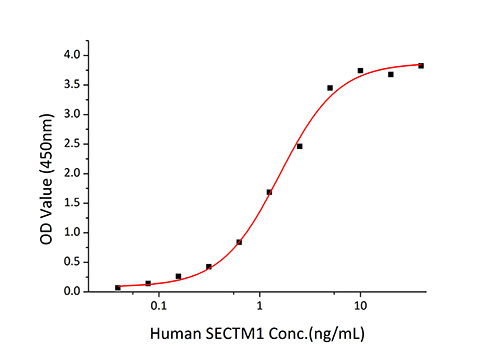Description
Recombinant Human SECTM1 Protein
The Recombinant Human SECTM1 Protein is a biologically active recombinant protein that plays a significant role in various cellular processes and signaling pathways in human biology. This protein is widely employed in immunological research, cell biology studies, protein-protein interaction analyses, and therapeutic development, providing researchers with a reliable tool for investigating SECTM1 function and its implications in health and disease.
This product (SKU: RPCB0400) is produced using advanced expression systems and features a C-hFc&His tag for convenient detection and purification. The protein exhibits a calculated molecular weight of 39.51 kDa with an observed molecular weight of 50-55 kDa under denaturing conditions, achieving ≥ 95 % as determined by SDS-PAGE.. Functional bioactivity has been validated through rigorous quality control assays, confirming its suitability for demanding research applications.
Key Features
| High Purity by Affinity Chromatography | |
| Mammalian & Bacterial Expression Systems | |
| High lot-to-lot consistency via strict QC |
| Product Name: | Recombinant Human SECTM1 Protein |
| SKU: | RPCB0400 |
| Size: | 20 μg , 100 μg |
| Reactivity: | Human |
| Synonyms: | SECTM1, K12 |
| Tag: | C-hFc&His |
| Calculated MW: | 39.51 kDa |
| Observed MW: | 50-55 kDa |
| Gene ID: | 6398 |
| Protein Description: | High quality, high purity and low endotoxin recombinant Recombinant Human SECTM1 Protein (RPCB0400), tested reactivity in HEK293 cells and has been validated in SDS-PAGE.100% guaranteed. |
| Endotoxin: | < 0.1 EU/μg of the protein by LAL method. |
| Purity: | ≥ 95 % as determined by SDS-PAGE. |
| Formulation: | Lyophilized from a 0.22 μm filtered solution of PBS, pH 7.4.Contact us for customized product form or formulation. |
| Bio-Activity: | Measured by its binding ability in a functional ELISA. Immobilized Human CD7 Protein at 1 μg/mL (100 μL/well) can bind SECTM1 with a linear range of 0.039-1.575 ng/mL.2.Measured by the ability of the immobilized protein to support the adhesion of Jurkat human acute T cell leukemia cells. When 8×104 cells/well are added to SECTM1 coated plates (5 μg/mL and 100 μL/well) in the ppresence of 10μg/ml PHA, approximately 40-50% cells will adhere specifically after 60 minutes at 37℃. |
| Reconstitution: | Centrifuge the vial before opening. Reconstitute to a concentration of 0.1-0.5 mg/mL in sterile distilled water. Avoid vortex or vigorously pipetting the protein. For long term storage, it is recommended to add a carrier protein or stablizer (e.g. 0.1% BSA, 5% HSA, 10% FBS or 5% Trehalose), and aliquot the reconstituted protein solution to minimize free-thaw cycles. |
| Storage: | Store at -20℃.Store the lyophilized protein at -20℃ to -80 ℃ up to 1 year from the date of receipt. After reconstitution, the protein solution is stable at -20℃ for 3 months, at 2-8℃ for up to 1 week. |
This protein, also known as K12, is a transmembrane and secreted protein with characteristics of a type 1a transmembrane protein of SECTM family. It is found in a perinuclear Golgi-like pattern and thought to be involved in hematopoietic and/or immune system processes. The human K12 protein has been shown to be primarily expressed in spleen, prostate, testis, small intestine, and in peripheral blood leukocytes. The K12 protein is expressed on the cell surface in such small amounts as to preclude detection. Alternatively, it may be that K12 on the cell surface is rapidly cleaved to generate a soluble K12 protein. Immunohistochemical analysis of peripheral blood cells shows that K12 is found in leukocytes of the myeloid lineage, with the strongest staining observed in granulocytes and no detectable expression in lymphocytes. May be involved in thymocyte signaling. It had been suggested a role for thymic microenvironment-produced K12 in regulation of thymocyte signaling and cytokine release, particularly in the setting of thymus pathology where IFN-gamma is upregulated such as myasthenia gravis. In addition, as a putative natural CD7 ligand, SECTM1/K12 may be responsible for the costimulatory role it plays in T cell activation.








